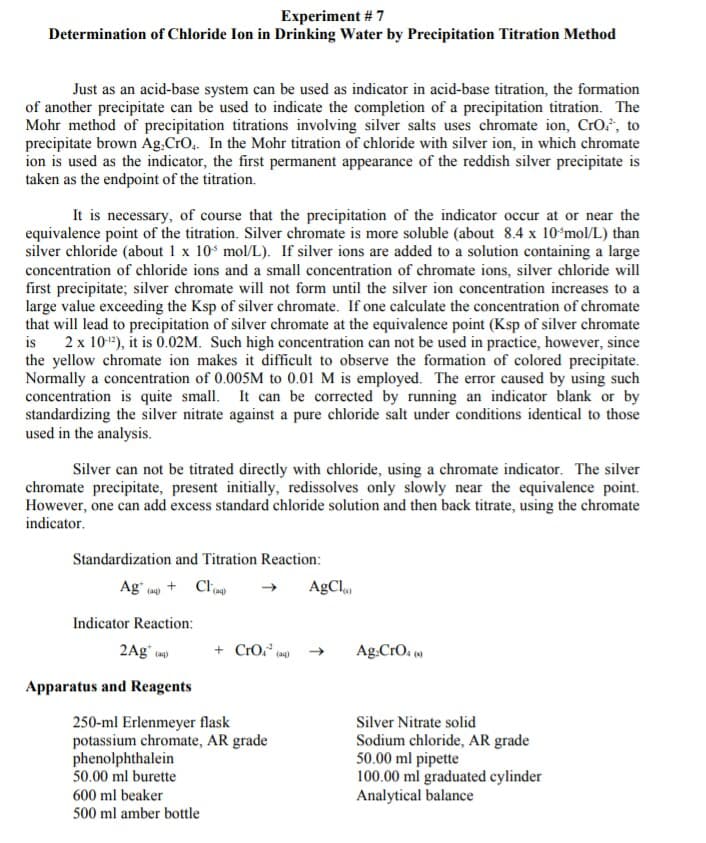Questions 2. What is an indicator? What is the purpose of an indicator blank? 3. What is the Mohr method limited to solution of pH values from 6 to 10? Show the chemical reaction involved in solution having pH <6.
Questions 2. What is an indicator? What is the purpose of an indicator blank? 3. What is the Mohr method limited to solution of pH values from 6 to 10? Show the chemical reaction involved in solution having pH <6.
Chemistry
10th Edition
ISBN:9781305957404
Author:Steven S. Zumdahl, Susan A. Zumdahl, Donald J. DeCoste
Publisher:Steven S. Zumdahl, Susan A. Zumdahl, Donald J. DeCoste
Chapter1: Chemical Foundations
Section: Chapter Questions
Problem 1RQ: Define and explain the differences between the following terms. a. law and theory b. theory and...
Related questions
Question
Subject: Analyyical Chemistry Laboratory
ANSWER ONLY QUESTIONS NUMBER 2 AND 3
THANK YOU SO MUCH

Transcribed Image Text:Questions
2. What is an indicator? What is the purpose of an indicator blank?
3. What is the Mohr method limited to solution of pH values from 6 to 10? Show the
chemical reaction involved in solution having pH <6.

Transcribed Image Text:Experiment # 7
Determination of Chloride Ion in Drinking Water by Precipitation Titration Method
Just as an acid-base system can be used as indicator in acid-base titration, the formation
of another precipitate can be used to indicate the completion of a precipitation titration. The
Mohr method of precipitation titrations involving silver salts uses chromate ion, CrO., to
precipitate brown Ag.CrO,. In the Mohr titration of chloride with silver ion, in which chromate
ion is used as the indicator, the first permanent appearance of the reddish silver precipitate is
taken as the endpoint of the titration.
It is necessary, of course that the precipitation of the indicator occur at or near the
equivalence point of the titration. Silver chromate is more soluble (about 8.4 x 10ʻmol/L) than
silver chloride (about 1 x 10 mol/L). If silver ions are added to a solution containing a large
concentration of chloride ions and a small concentration of chromate ions, silver chloride will
first precipitate; silver chromate will not form until the silver ion concentration increases to a
large value exceeding the Ksp of silver chromate. If one calculate the concentration of chromate
that will lead to precipitation of silver chromate at the equivalence point (Ksp of silver chromate
is
2 x 10"), it is 0.02M. Such high concentration can not be used in practice, however, since
the yellow chromate ion makes it difficult to observe the formation of colored precipitate.
Normally a concentration of 0.005M to 0.01 M is employed. The error caused by using such
concentration is quite small. It can be corrected by running an indicator blank or by
standardizing the silver nitrate against a pure chloride salt under conditions identical to those
used in the analysis.
Silver can not be titrated directly with chloride, using a chromate indicator. The silver
chromate precipitate, present initially, redissolves only slowly near the equivalence point.
However, one can add excess standard chloride solution and then back titrate, using the chromate
indicator.
Standardization and Titration Reaction:
Ag" + Clieo
AgCl
(aq)
Indicator Reaction:
2Ag (a)
+ CrO,",
Ag.CrO. ()
(aq)
Apparatus and Reagents
250-ml Erlenmeyer flask
potassium chromate, AR grade
phenolphthalein
50.00 ml burette
Silver Nitrate solid
Sodium chloride, AR grade
50.00 ml pipette
100.00 ml graduated cylinder
Analytical balance
600 ml beaker
500 ml amber bottle
Expert Solution
This question has been solved!
Explore an expertly crafted, step-by-step solution for a thorough understanding of key concepts.
Step by step
Solved in 3 steps

Knowledge Booster
Learn more about
Need a deep-dive on the concept behind this application? Look no further. Learn more about this topic, chemistry and related others by exploring similar questions and additional content below.Recommended textbooks for you

Chemistry
Chemistry
ISBN:
9781305957404
Author:
Steven S. Zumdahl, Susan A. Zumdahl, Donald J. DeCoste
Publisher:
Cengage Learning

Chemistry
Chemistry
ISBN:
9781259911156
Author:
Raymond Chang Dr., Jason Overby Professor
Publisher:
McGraw-Hill Education

Principles of Instrumental Analysis
Chemistry
ISBN:
9781305577213
Author:
Douglas A. Skoog, F. James Holler, Stanley R. Crouch
Publisher:
Cengage Learning

Chemistry
Chemistry
ISBN:
9781305957404
Author:
Steven S. Zumdahl, Susan A. Zumdahl, Donald J. DeCoste
Publisher:
Cengage Learning

Chemistry
Chemistry
ISBN:
9781259911156
Author:
Raymond Chang Dr., Jason Overby Professor
Publisher:
McGraw-Hill Education

Principles of Instrumental Analysis
Chemistry
ISBN:
9781305577213
Author:
Douglas A. Skoog, F. James Holler, Stanley R. Crouch
Publisher:
Cengage Learning

Organic Chemistry
Chemistry
ISBN:
9780078021558
Author:
Janice Gorzynski Smith Dr.
Publisher:
McGraw-Hill Education

Chemistry: Principles and Reactions
Chemistry
ISBN:
9781305079373
Author:
William L. Masterton, Cecile N. Hurley
Publisher:
Cengage Learning

Elementary Principles of Chemical Processes, Bind…
Chemistry
ISBN:
9781118431221
Author:
Richard M. Felder, Ronald W. Rousseau, Lisa G. Bullard
Publisher:
WILEY